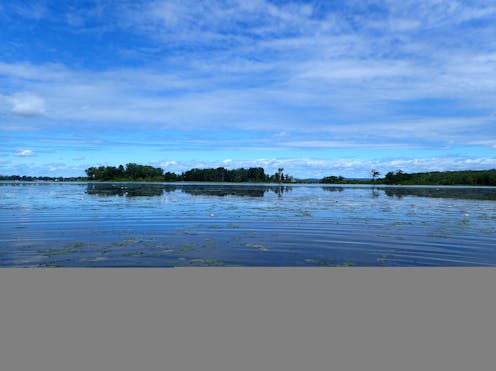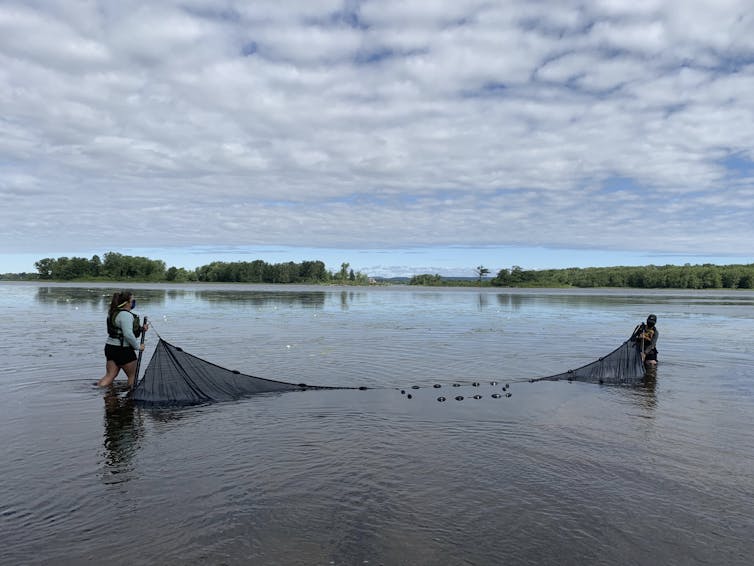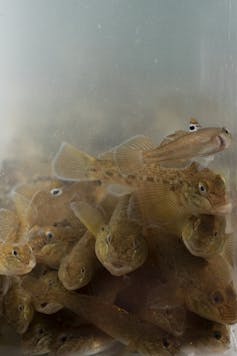
Biological invasions are among the main factors contributing to the significant decline in biodiversity worldwide.
Several invasive species, such as the zebra mussel (Dreissena polymorpha) are native to the Ponto-Caspian region, which includes the Black, Caspian and Azov Seas, and were imported to North America by transoceanic ships. These species are known to have disrupted ecosystems around the world, including those of the Great Lakes and St. Lawrence River.
However, the impacts of Ponto-Caspian invaders on native biodiversity, although significant, appear to have been less extensive in the St. Lawrence River than in the Great Lakes. This phenomenon might be explained by the river’s weaker conductivity.
Conductivity is the ability of water to conduct an electric current, which results from a concentration of dissolved minerals. It is highly dependent on salinity, the concentration of all salts dissolved in water.

This article is part of our series, The St. Lawrence River: In depth. Don’t miss new articles on this mythical river of remarkable beauty. Our experts look at its fauna, flora and history, and the issues it faces. This series is brought to you by La Conversation.
Invasive species that originate from the Ponto-Caspian region have evolved in brackish waters, which are less salty than seawater, but still rich in essential minerals. When they are introduced into habitats that are low in minerals, or weaker conductivity as in the river, these species have difficulty surviving.
We are studying how conductivity gradients in the St. Lawrence River promote aquatic diversity in the presence of invasive species. These gradients provide native species with habitats that are unfavourable for invasive species.
The round goby invades the St. Lawrence
The round goby (Neogobius melanostomus), Ponto-Caspian invader, is an established fish that has become widespread in the St. Lawrence River within the past two decades following its introduction into the Great Lakes. It has disrupted coastal fish communities because it reproduces quickly and frequently, is highly adaptable to various habitat conditions, and behaves aggressively.
The presence of the goby has been associated with the decline of several native fish species, such as the Johnny Darter, and the spread of certain fish diseases, such as viral hemorrhagic septicemia. There is also evidence that the round goby contributes to the spread of avian botulism and the bioaccumulation of contaminants, such as mercury, in the aquatic food chain.
In addition, these impacts are expected to worsen with climate change, as round goby growth rates will increase faster with the rise of water temperatures in the Great Lakes and St. Lawrence River.
Most of the ecological impacts of the round goby on native fish and macroinvertebrate communities (animals without a spine and visible to the naked eye) appear to depend on its density and invasion status. The impacts will be greater in areas where the species has been present in large numbers and for a long time.
Since the spatial distribution of several invasive species (including zebra mussels) in the St. Lawrence River appears to be influenced by the water conductivity gradient, it is debatable whether this habitat characteristic represents a limiting factor in the invasion of freshwater environments by the round goby.
A matter of refuge
Environmental heterogeneity, namely the variation in the physical and ecological characteristics of the landscape, can play an important role in maintaining the diversity and abundance of native species in goby-invaded ecosystems. In fact, this diversity can generate refuges for native species in the face of biological invasion when environmental conditions, such as water conductivity, restrict the abundance and impact of invaders by limiting their survival.
There are compelling studies — but of a limited number — on the Great Lakes that suggest that wetlands (seagrass beds and marshes) are unfavourable to some key aquatic invaders, notably the round goby.

Our work has also shown that both habitat types, the conductivity gradient and local wetlands, limit round goby dominance. Even in places where they are present in large numbers, wetlands help mitigate their negative effects on native communities. This may be linked to the structuring effects of vegetation, which provide favourable conditions for maintaining fish and macroinvertebrate diversity.
Important tools for biodiversity conservation
The results of this study, while highly relevant to the risk assessment and management of round goby, were based on observations of a limited portion of the St. Lawrence River. Two major fish inventories along the St. Lawrence, the Fish Identification Nearshore Survey (FINS) and the Ichthyological Monitoring Network (RSI), conducted by the River Institute and the Québec Department of Forestry, Wildlife and Parks, respectively, now provide the opportunity to test the phenomenon on a much larger spatial scale — practically the entire freshwater portion of the St. Lawrence River.
Our research is one of the few freshwater studies to date that has addressed the essential but little-known role of refuges in an ecosystem with diverse environmental conditions. In addition to reducing the effects of the invasion on native biodiversity, these areas ensure their sustainability. The mitigation of the presence and quantity of the round goby in the St. Lawrence River by low-conductivity waters and the presence of wetlands present a conservation tool that can contribute to the preservation of this culturally and socio-economically important river system.

In addition, the relationship between goby abundance and water conductivity is a simple but informative tool in assessing the risk to habitats that are not yet colonized by the round goby (such as the St. Lawrence River tributaries) that may harbour fish species at risk, including the eastern sand darter (Ammocrypta pelludica), the channel darter (Percina copelandi) and the pugnose shiner (Notropis anogenus).
Our research highlights the importance of preserving a wide variety of natural habitats, including wetlands, for their beneficial effects in mitigating the negative impacts of biological invasions on freshwater biodiversity.
In particular, we recommend protecting the St. Lawrence River wetlands as a critical step in sustaining this ecosystem resource.
Matthew Windle of the River Institute provided data and contributed to the project. Louis Astorg developed ideas, directed and implemented the first study of our research.
Alison Derry is a member of the Interuniversity Group in Limnology (GRIL). She has received funding from the Fonds de recherche du Québec (FRQNT) - nature et technologies and from the Natural Sciences and Engineering Research Council of Canada (NSERC), Alliance project with the River Institute.
Cristina Charette is a member of the Interuniversity Research Group in Limnology (GRIL). She has received funding from the Fonds de recherche du Québec - nature et technologies (FRQNT) and Mitacs.
Olivier Morissette is a member of Aquatic Resources Quebec (RAQ). He has received funding from the Quebec Research Fund (FRQNT) - nature and technologies and the Natural Sciences and Engineering Research Council of Canada (NSERC).
This article was originally published on The Conversation. Read the original article.







